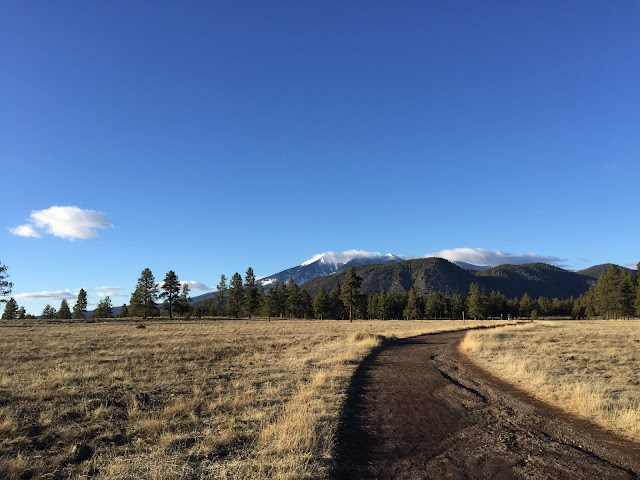A Tribute to Running
I have always had an affinity for running. I had the example of my father, who was a cross country runner, and later amateur competitor when resumed his hobby around the early 1980s when I was a child. I was also fairly good natural runner in grade school, and placed well in cross country events without training, although never won, but I was a better sprinter, and once won a sprint in 5th grade, again without training. It’s a relatively inexpensive hobby, and is logistically easy, if not physically easy, the only significant cost being special shoes, which must be replaced every 300 to 500 miles1.
 |
| My favorite place to run in Flagstaff, Arizona - Buffalo Park. The snow-capped San Francisco Peaks loom over the trail. |
 |
| Finishing a 5k on Signal Mounain, Tennessee, February 5, 2011. |
Unfortunately my running career got derailed somewhat by difficulties with my right knee around junior high school2. I had this surgically corrected after I graduated high school in 1992 and got back on track.
I ran about 2 years while I was in college, and was in Air Force ROTC one year, but injured the knee again doing a standing long jump, which was part of the fitness test3. This caused me to quit ROTC, although the knee did eventually heal back to about 90% and again became almost pain free. After that I switched to walking and hiking, but eventually started running again, to get the cardiovascular benefits, and because I felt a very strong compulsion to run.
 |
| Another beautiful place I've been able to run: atop Cameron Hill overlooking the downtown of Chattanooga, Tennessee and the Ridge and Valley region of the Appalachian Mountains, 2012. |
In my late twenties, I fell in love with a young woman, and decided that I needed to lose weight and get in shape, and began running again, very seriously. I increased the mileage, and ran up to 6 days a week. By the time I reached 30, I realized that I needed to back off. I didn't get the girl and knee injuries kept plaguing me, but I figured out that I could continue running if I ran only intervals, so I usually ran .1 to .2 mile intervals with equal distance walking intervals between. Running took me to many interesting and beautiful locations. I stopped running on concrete, then stopped running on pavement, finally becoming a full-time trail runner. The softer surfaces of trails helps avoid joint injuries and combines running with my lifelong hobby of hiking.
 |
| The view from the East Overlook on Raccoon Mountain, just outside Chattanooga, Tennessee, March 13, 2014. The Tennessee River is below a nearly full moon in the fading evening light. |
 |
| Running has taken me many interesting historical places. This is a trail I ran at Valley Forge in Pennsylvania, when I was on a business trip in 2009. |
A few years later, a beautiful young woman talked me into starting again, and I ran my first timed 5k race at 37. The time was terrible, and I was embarrassed by it so I trained up pretty well for another 5k race and put in a time somewhat above 27 minutes, which I considered good, and then quit again due to injury.
Yet another beautiful young woman talked me into training for obstacle course races the next year (see the pattern?). I did a couple of those. Then I got pretty significant injuries to my right knee and left ankle and had to take about a year off. I was not happy with that and knew that I wanted and needed to resume running. Unfortunately I put on a lot of weight that year, waiting for the injuries to heal, and generally feeling sorry for myself instead of rehabbing properly and controlling my diet.
Yet another beautiful young woman talked me into training for obstacle course races the next year (see the pattern?). I did a couple of those. Then I got pretty significant injuries to my right knee and left ankle and had to take about a year off. I was not happy with that and knew that I wanted and needed to resume running. Unfortunately I put on a lot of weight that year, waiting for the injuries to heal, and generally feeling sorry for myself instead of rehabbing properly and controlling my diet.
 |
| At an obstacle course/adventure race in Lookout Valley near Chattanooga, October 27, 2012. I can't remember if this was in Tennessee or Georgia. The things women will talk you into! |
Things I have changed this year:
- Lost over 20 pounds
- Clean diet - mostly pescetarian to vegetarian during the work week
- Elevate legs about 30 minutes after running for about 10 minutes.
- Sleep on a bed with elevated legs.
- Stretching - I can touch the floor for the first time in many, many years.
- Cut back on ibuprofen. I know this counter-intuitive, but anti-inflammatory drugs like ibuprofen are believed to have the side effect that although they provide pain relief and reduce inflammation in the short term, they prolong healing. I’m down from a minimum of 600 mg per day to 200 mg first thing in the morning. I originally did this because my back pain lessened when I got a new bed, but I think it has been beneficial for running as well.
This year, I was very successful at building up my running distance to the point that I could run as much as 3.8 miles in a single run, although I rarely have run more than 3 miles continuously. Usually my total distance is much farther, anywhere from 4 to 6 miles including walking segments. As I have gotten older, and after many years of fighting injury, I learned to simply stop running when I felt the distinct twinges of pain that indicate coming injury. I enjoy running enough that I prefer to avoid injury, even at the cost of time. Many runners are very competitive and would never allow a slow time, even at the cost of injury. Therefore, for the most part, the only successful competitive runners have durable muscles and joints. You can't succeed a racing unless you can avoid injury. I'm personally more interested in running for general fitness and enjoyment.
This year I was able to use running as a tool to train myself for a single day hike across the Grand Canyon (a "rim to rim"). This was a 24 mile day hike with more than 5000 feet of downhill from the North Rim and over 4000 feet of elevation gain climbing up the South Rim. Much of the trail was steep but I was still tempted to take off running when I saw the smooth, gradually downhill trail in the canyon of Bright Angel Creek. It was such a great feeling to hike so far and still feel so good. Running has provided great joy as well as great fitness to me in middle age. I hope to not have to stop running until I'm in my 60s.
I love running. It keeps me in shape and enables my other hobbies that require fitness. I'm 44 years old, feel better than ever, and have no plans to quit running anytime soon.
 |
| Perfect trail for running at Cheyenne Mountain State Park, in Colorado Springs. |
I love running. It keeps me in shape and enables my other hobbies that require fitness. I'm 44 years old, feel better than ever, and have no plans to quit running anytime soon.
Footnotes and Commentary
1 Although many sources claim running shoes will last 500 miles, in my experience, current running shoes must be replaced every 300 miles. I believe that the manufacturers could make shoes that last longer, but won’t because they would make less money. They control the longevity of shoes vs. price based upon how often the consumer is willing to spend the money.
2 I suffered from a fairly severe case of Osgood-Schlatter’s syndrome, a very painful swelling on the tibial tuberosity on the front of the knee, just below the kneecap. This prevented me from participating much in athletics, although I sometimes think I spent too much time indulging worry of injury more than the reality of it. I know it was extremely painful though. I sometimes would lay in bed and the knee would throb for hours, keeping me awake, even the weight of the bedsheets at night would hurt the knee. The injury eventually calcified and I had surgery to file off the bone. This achieved good results but I re-injured it in ROTC and has recovered only to about 90% over the years.
3 The Air Force got rid of standing long jump as a requirement for a long time but I read somewhere that it is back. What does that have to do with serving in the Air Force? The requirement is senseless, in my opinion.





Comments
Post a Comment